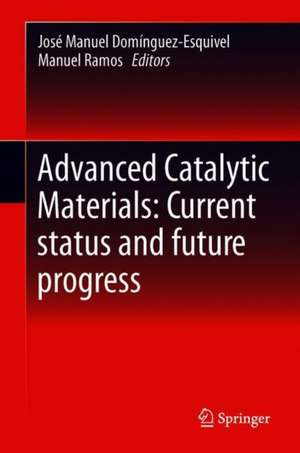Advanced Catalytic Materials: Current Status and Future Progress
Editat de José Manuel Domínguez-Esquivel, Manuel Ramosen Limba Engleză Hardback – 15 oct 2019
- Describes computational methods, experimental synthesis and advanced characterization for novel catalytic materials;
- Examines catalytic materials and corresponding engineering applications with a focus on low contaminant fuel production and derivatives;
- Covers the application of computer assisted quantum mechanical for fundamental understanding of electronicstructure of molecular dimension catalytic materials.
Preț: 562.86 lei
Preț vechi: 703.57 lei
-20% Nou
Puncte Express: 844
Preț estimativ în valută:
107.71€ • 115.17$ • 89.80£
107.71€ • 115.17$ • 89.80£
Carte tipărită la comandă
Livrare economică 14-21 aprilie
Preluare comenzi: 021 569.72.76
Specificații
ISBN-13: 9783030259914
ISBN-10: 3030259919
Pagini: 223
Ilustrații: VIII, 223 p. 112 illus., 64 illus. in color.
Dimensiuni: 155 x 235 mm
Greutate: 0.45 kg
Ediția:1st ed. 2019
Editura: Springer International Publishing
Colecția Springer
Locul publicării:Cham, Switzerland
ISBN-10: 3030259919
Pagini: 223
Ilustrații: VIII, 223 p. 112 illus., 64 illus. in color.
Dimensiuni: 155 x 235 mm
Greutate: 0.45 kg
Ediția:1st ed. 2019
Editura: Springer International Publishing
Colecția Springer
Locul publicării:Cham, Switzerland
Cuprins
Chapter 1. One brief introduction to Catalytic Materials.- Chapter 2. Synthesis of Novel Catalytic Materials: Titania nanotubes and Transition Metal Carbides, Nitrides and Sulfides.- Chapter 3. Theoretical Insights into the Electronic Structure and Catalytic Activity on MoS2-based Catalyst.- Chapter 4. Catalytic materials for hydrodesulfurization processes Experimental strategies to improve their performance.- Chapter 5. Electron Microscopy Techniques to Study Structure/Function relationships in Catalytic Materials.- Chapter 6. In Situ Upgrading via Hot Fluid and Nano-Catalyst Injection.- Chapter 7. Porosity and Fractality of MoS2 and MoS2/Co Catalytic Spheres.- Chapter 8. Catalytic Ni/CeO2 nanorods and Ag/CeO2 nanotubes for hydrogen production by methanol reforming.- Chapter 9. Effective visible light photodegradation of paraoxon with pure and doped TiO2.- Chapter 10. Ternary phase NiMoWS2 catalytic material for hydrodesulfurization.
Notă biografică
Prof. Dr. José Manuel Domínguez-Esquivel is a senior researcher in the Mexican Petroleum Institute (IMP) in México City. His 30 years of expertise in catalytic materials comprehends novel aspects of catalysis and catalysts, such as synthesis, evaluation, characterization and theoretical modeling. He has been a productive contributor for diverse peer-review Journal of Citation Report journals, and authoring of more than 150 peer-reviewed manuscripts in the field of catalysis, physical-chemistry, metallic nanoparticles and material science. He obtained his doctoral degree with honors from Université Claude Bernard in Lyon, France. He is ranked in senior level-III category of Mexican National Researcher System of Consejo Nacional de Ciencia y Tecnología (CONACyT-México). He has contributed in the co-organization of scientific symposia for catalytic materials in the framework of International Materials Research Congress which is a joint meeting between Sociedad Mexicana de Materiales (SMM) and Materials Research Society (MRS) since 2008. He currently resides at Mexico City.
Prof. Dr. Manuel Ramos is a research professor at The Departamento de Física y Matemáticas at Universidad Autóonoma de Ciudad Juárez, which is a large urbanborder town area between USA and México. In 2010, obtained a doctoral degree from University of Texas at El Paso in Materials Science and Engineering; he has been a visiting scientist scholar at Center for the Integration of Nanotechnologies at Sandia National Laboratory in Albuquerque, NM. His research expertise is focused on theoretical and experimental studies of heterogeneous catalytic materials, nanoparticles and two-dimensional layered nanostructures using a combination of computer-assisted simulations and extensive electron microscopy characterization including in-situ operando techniques and recently atom probe tomography. Has co-authored about 45 JCR peer-reviewed manuscripts in the literature and several conference presentations in Puerto Rico, USA, Brazil, Canada, México, France and Germany. And has contributed in the co-organization of scientific symposia for catalytic materials in the framework of International Materials Research Congress which is a joint meeting between Sociedad Mexicana de Materiales and Materials Research Society since year 2014. He is ranked as level-I on Mexican National Researcher System of Consejo Nacional de Ciencia y Tecnología (CONACyT-México).
Textul de pe ultima copertă
This book presents advances in computational methods, experimental synthesis, and advanced characterizations for novel catalytic materials. The authors show how catalytical materials can be used for various engineering oil & gas applications – mainly in low contaminants fuel production. All contributors, describe in detail novel experimental and theoretical techniques techniques and concepts for synthesis, evaluation and scaling catalytic materials and research advances in evaluation, extensive characterization and theoretical modeling using computer assisted methods and algorithms.
- Describes computational methods, experimental synthesis and advanced characterization for novel catalytic materials;
- Examines catalytic materials and corresponding engineering applications with a focus on low contaminant fuel production and derivatives;
- Covers the application of computer assisted quantum mechanical for fundamental understanding of electronicstructure of molecular dimension catalytic materials.
Caracteristici
Describes computational methods, experimental synthesis and advanced characterization for novel catalytic materials Examines catalytic materials and corresponding engineering applications with a focus on low contaminant fuel production and derivatives Covers the application of computer assisted quantum mechanical for fundamental understanding of electronic structure of molecular dimension catalytic materials
